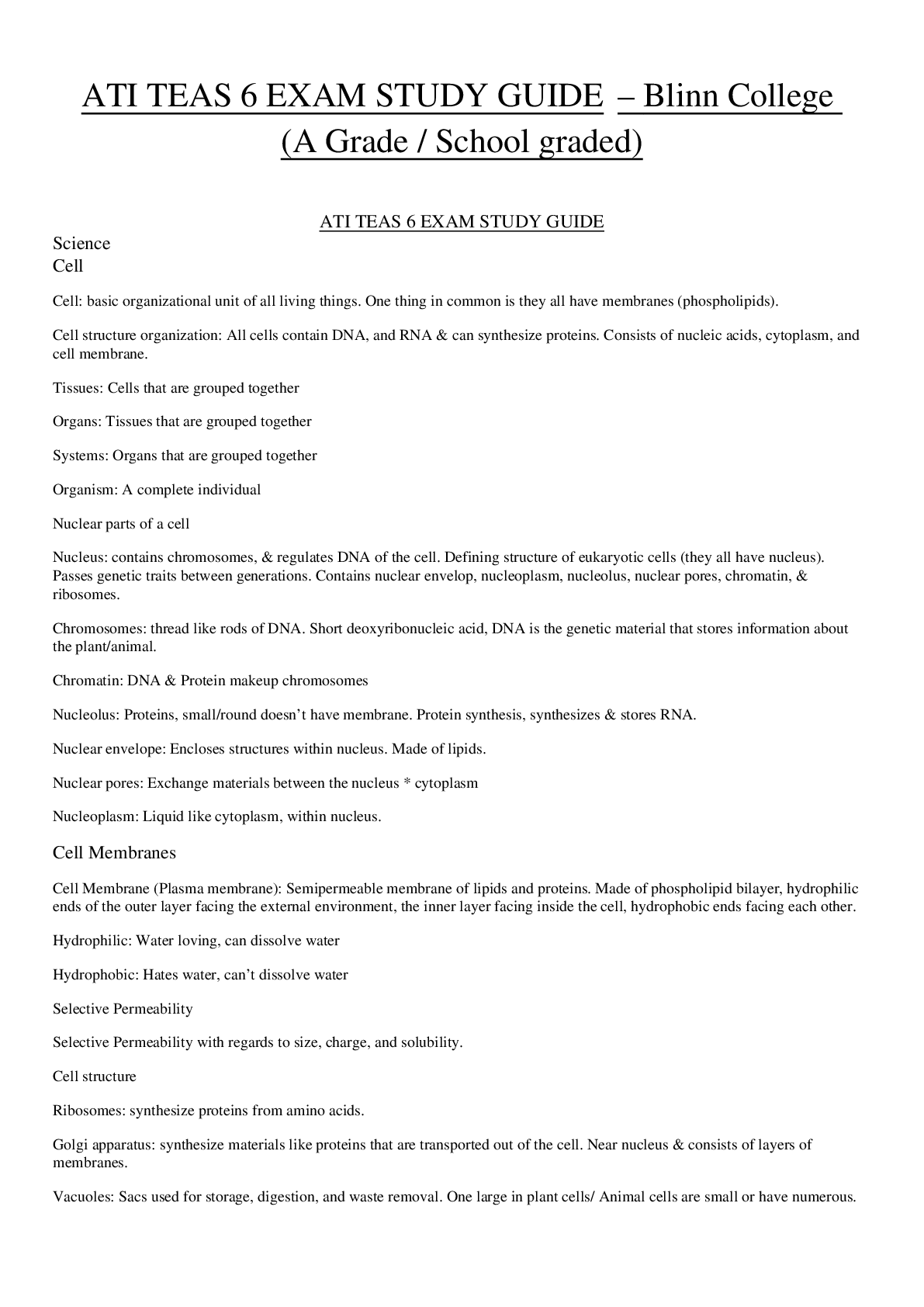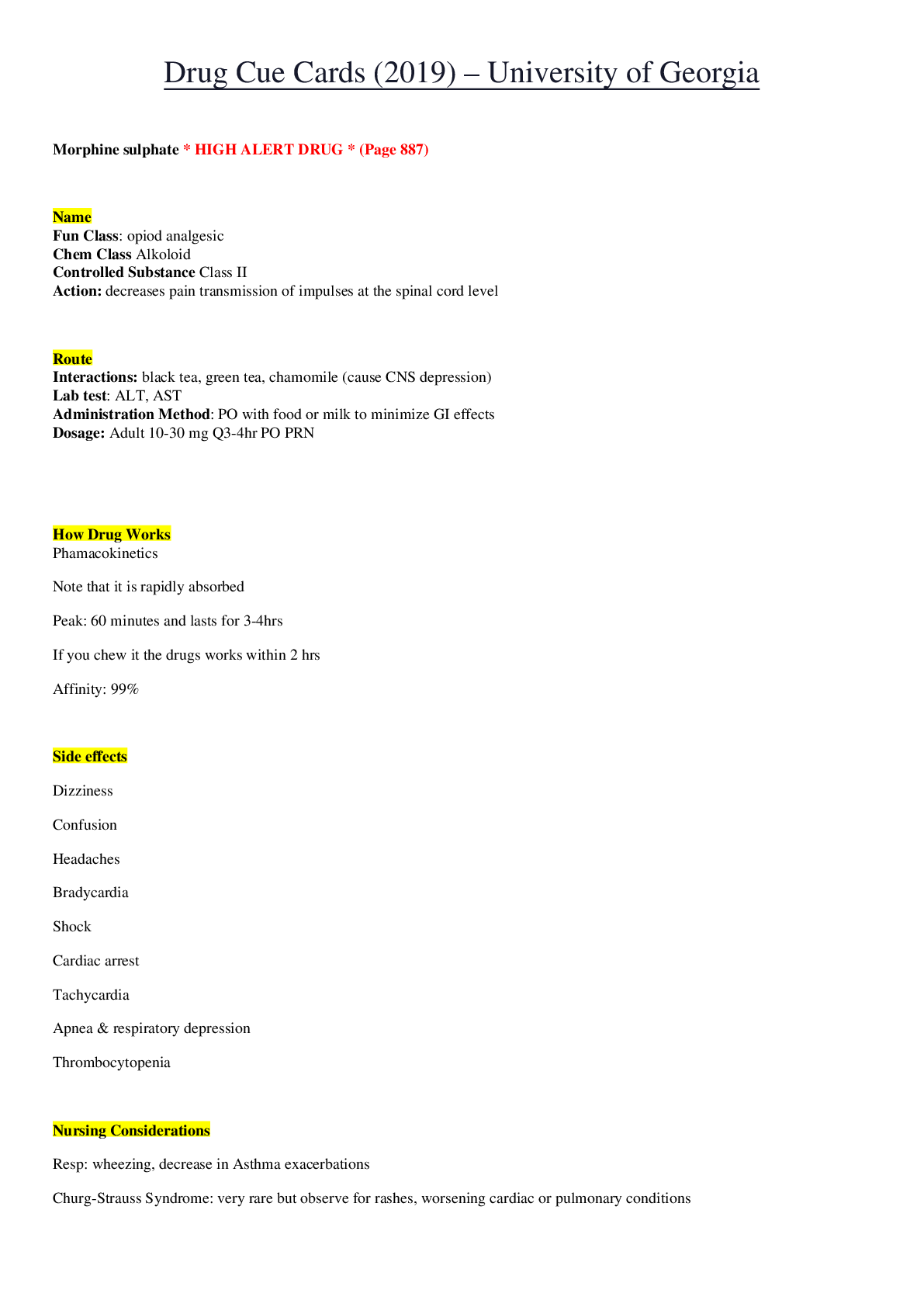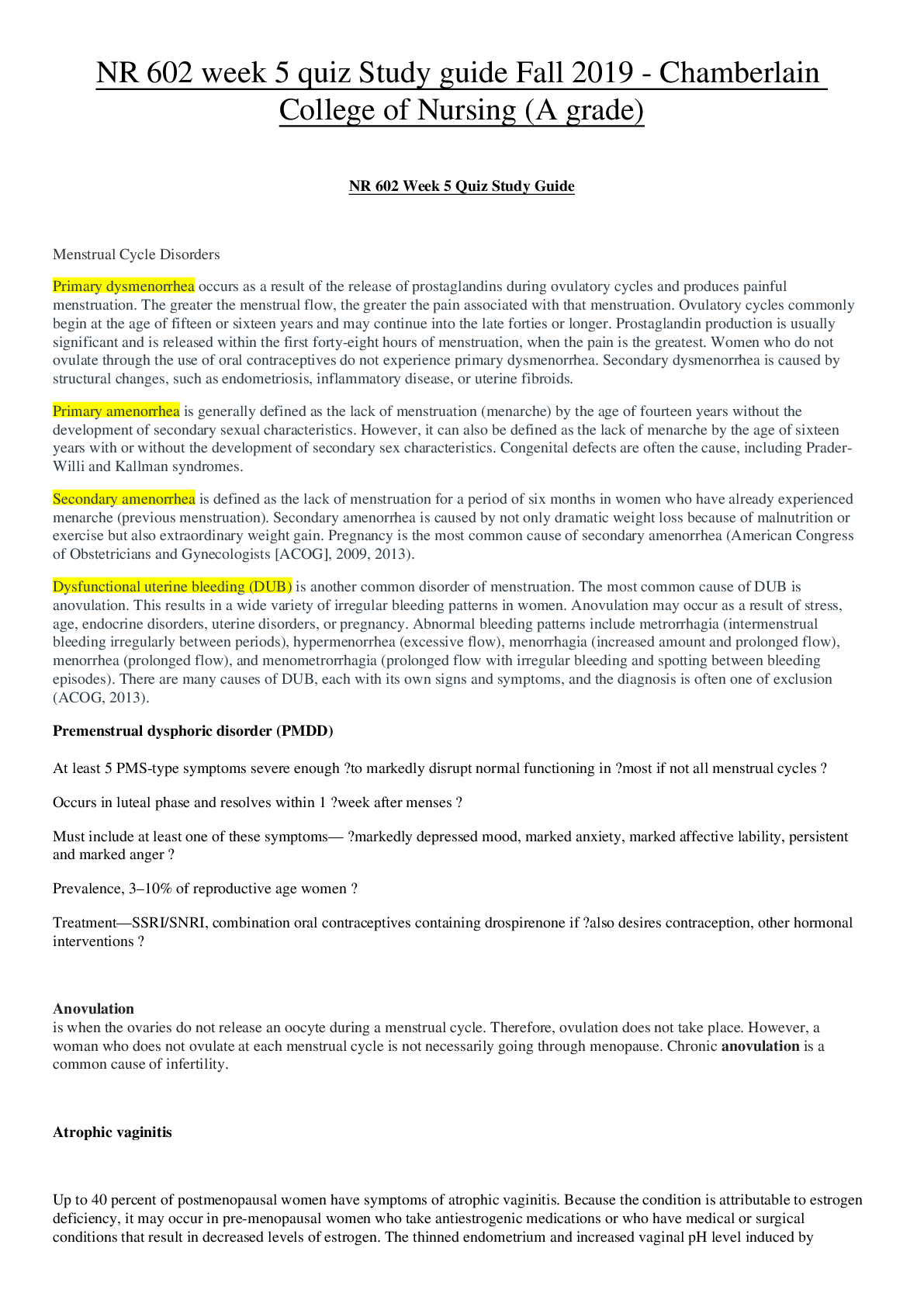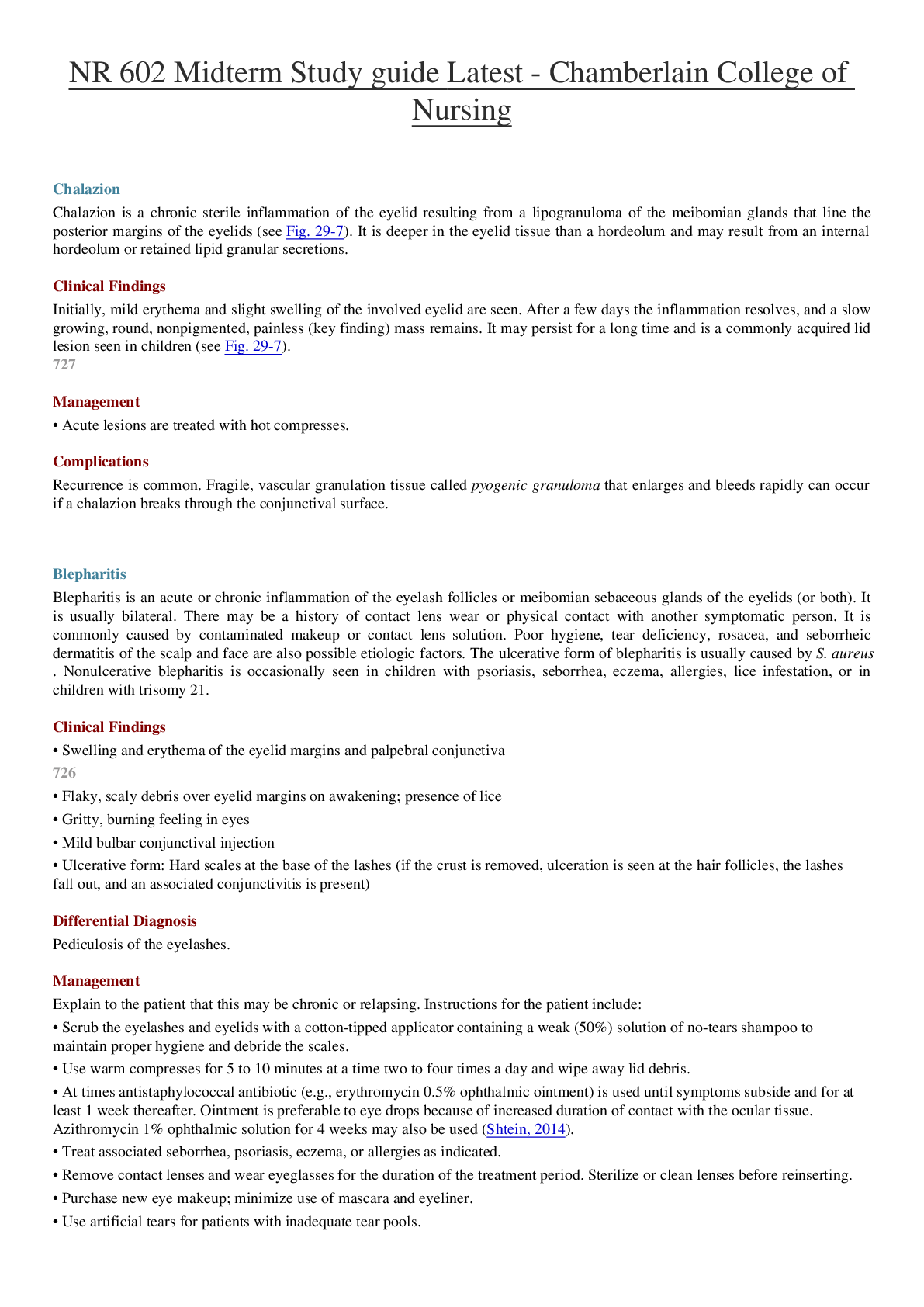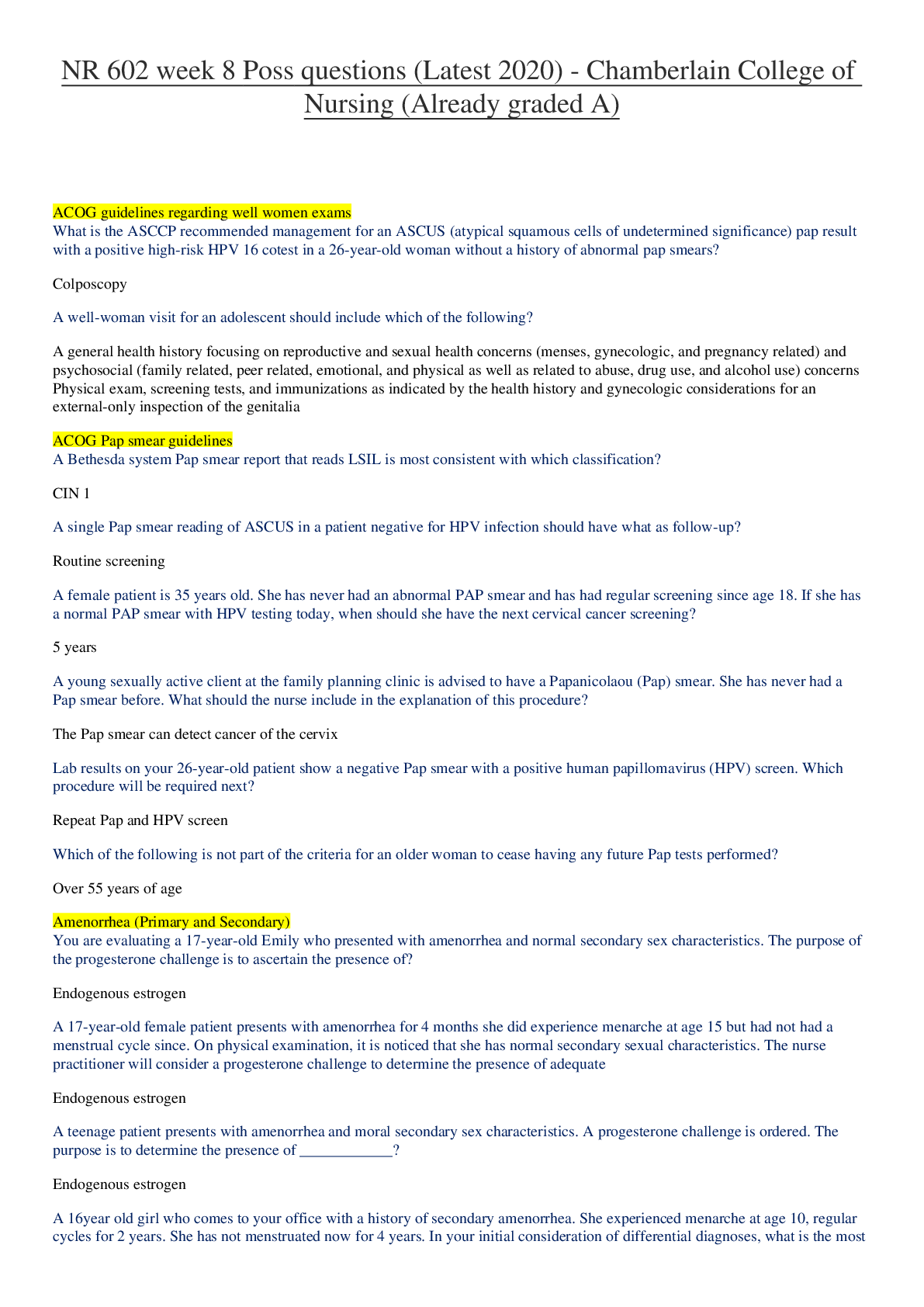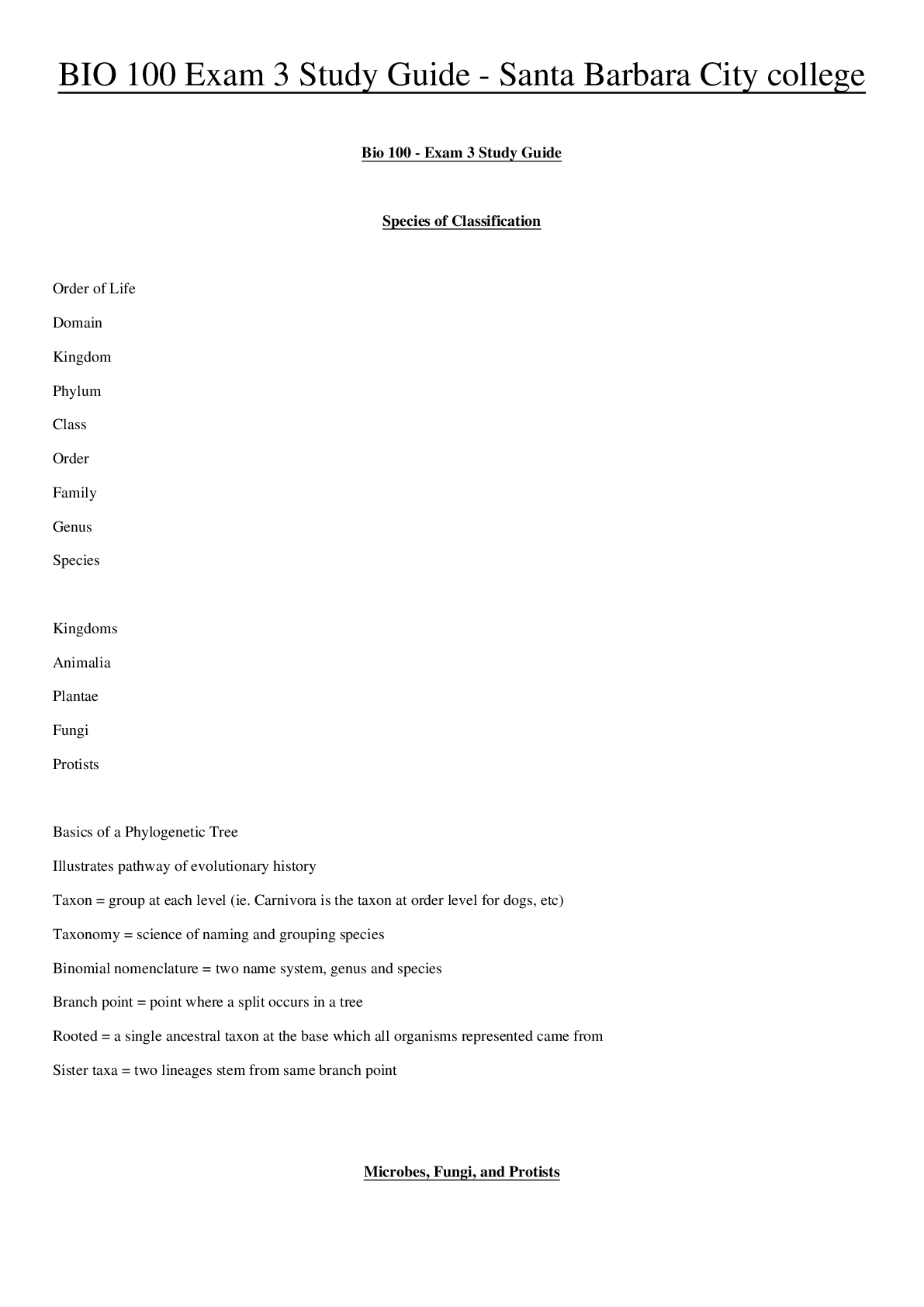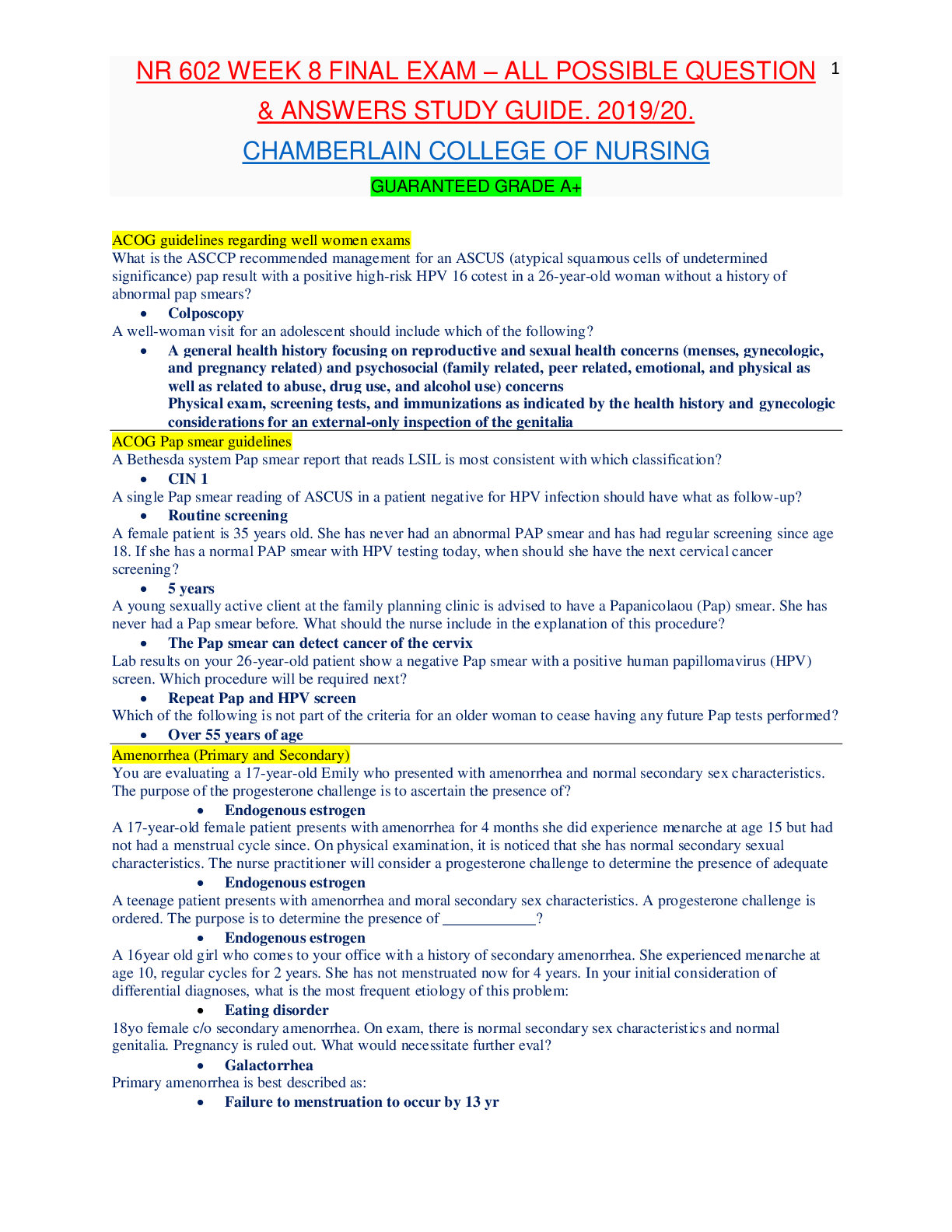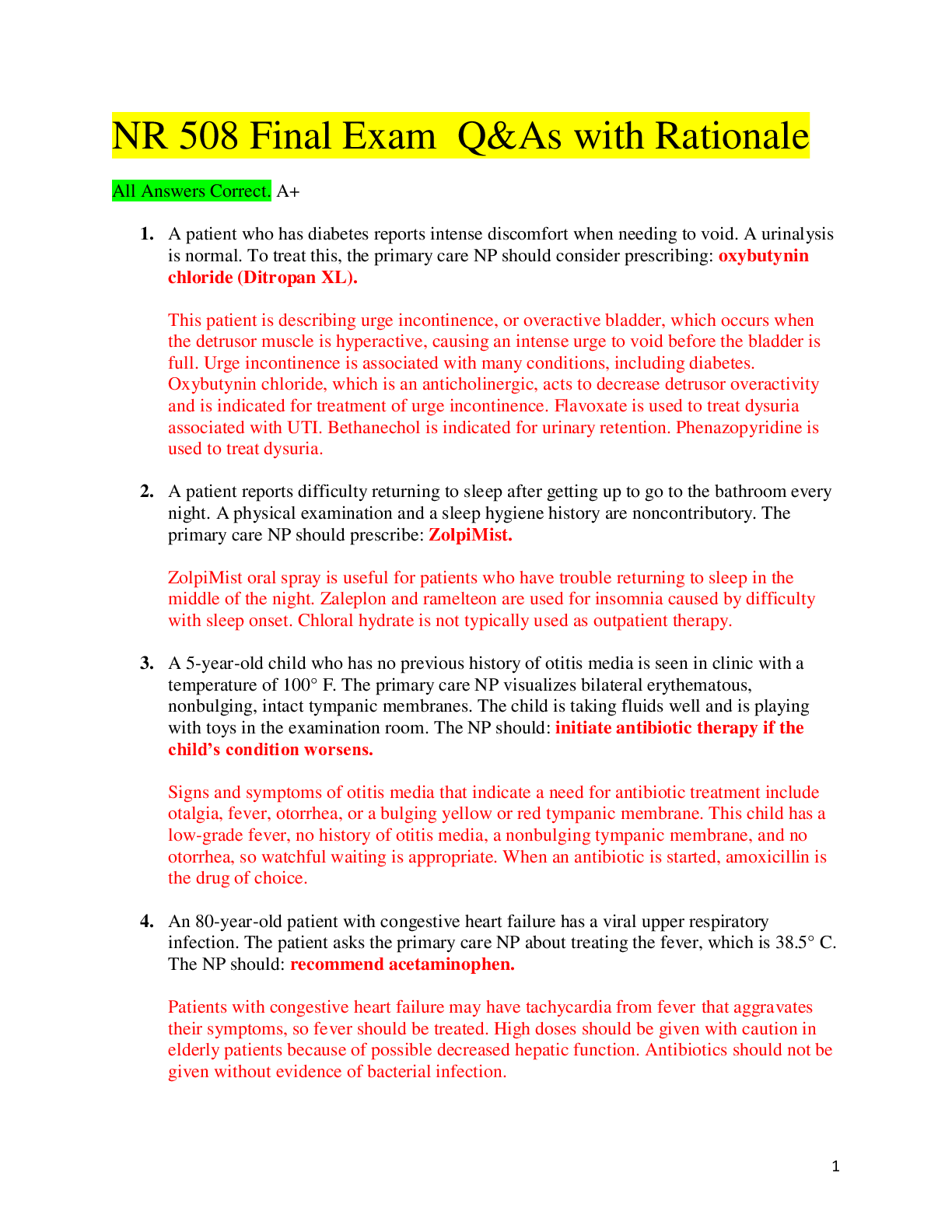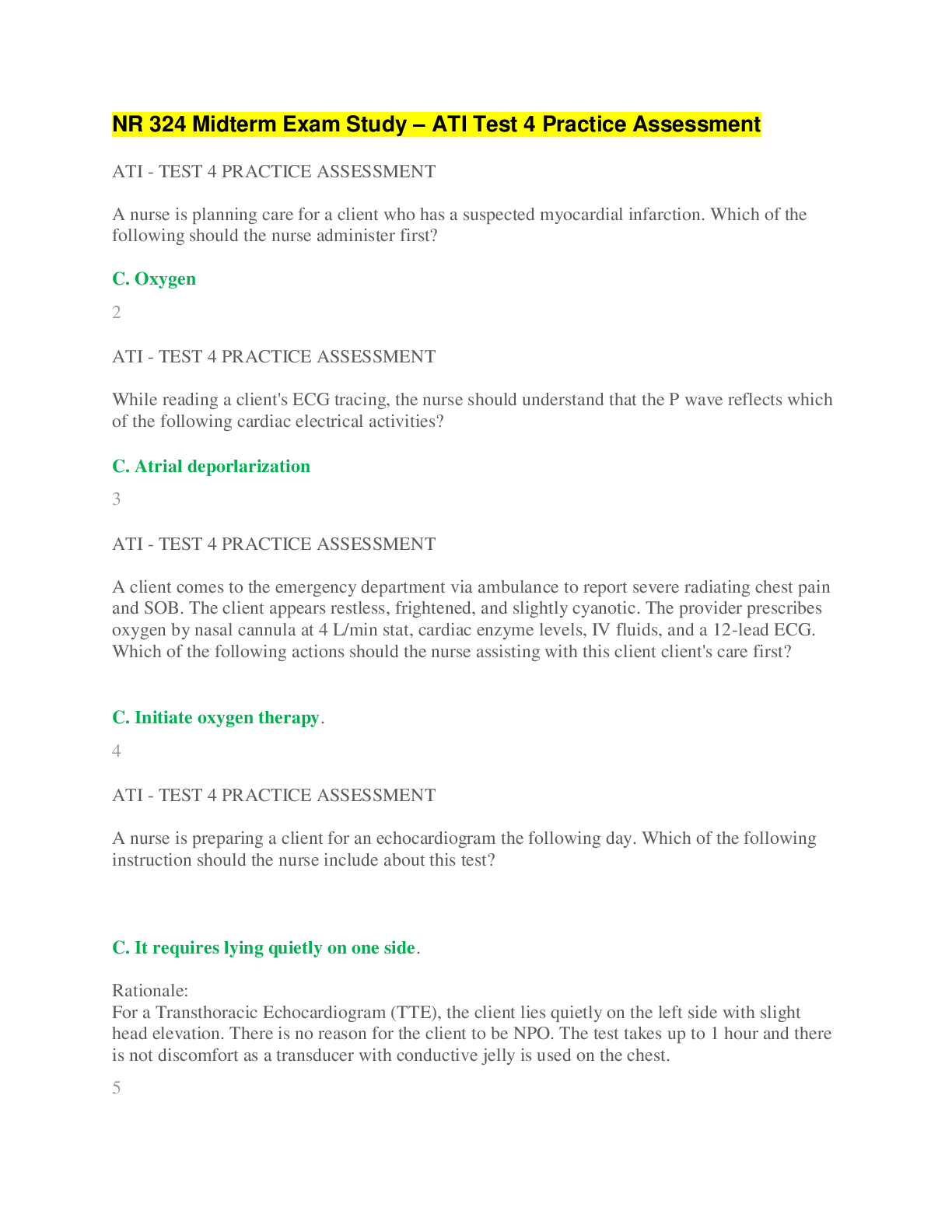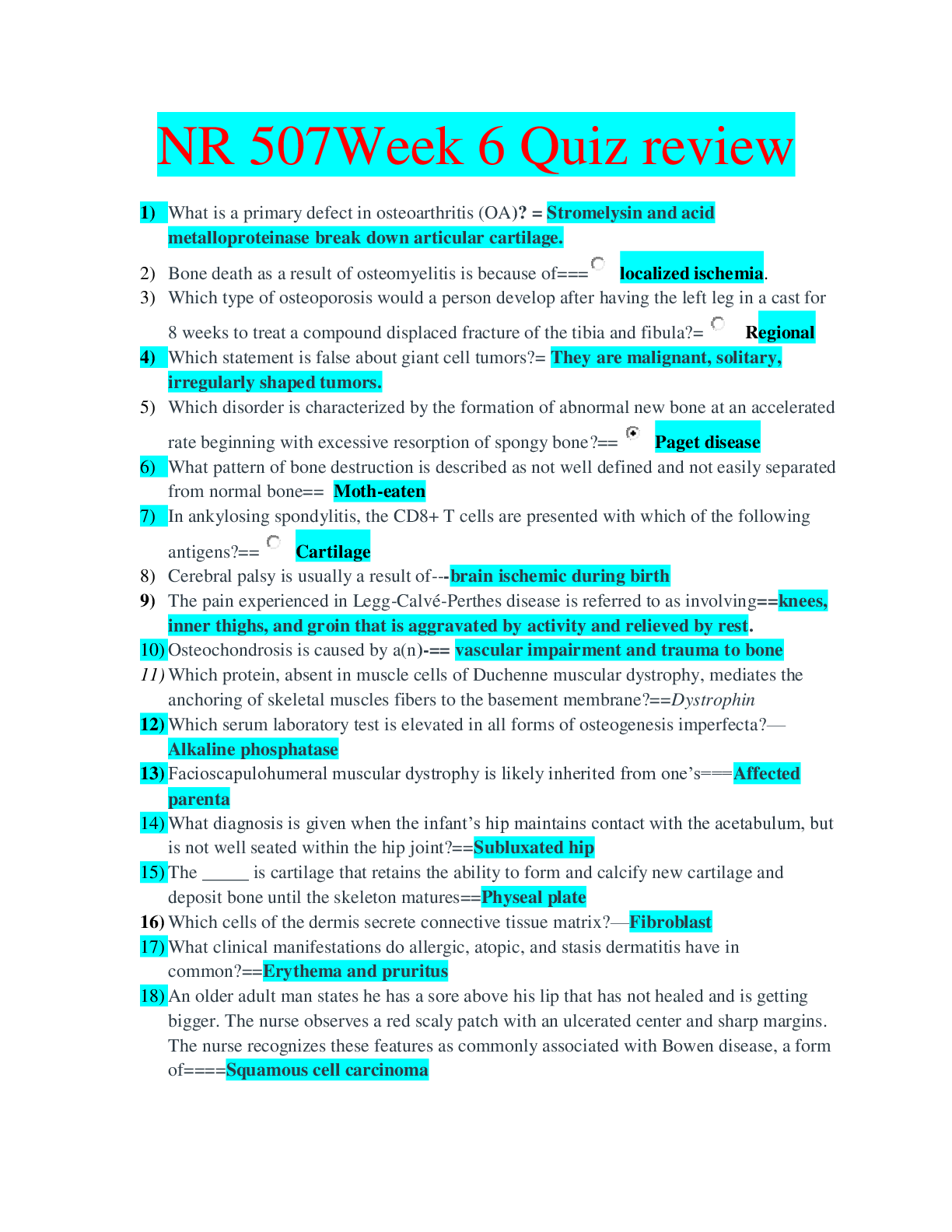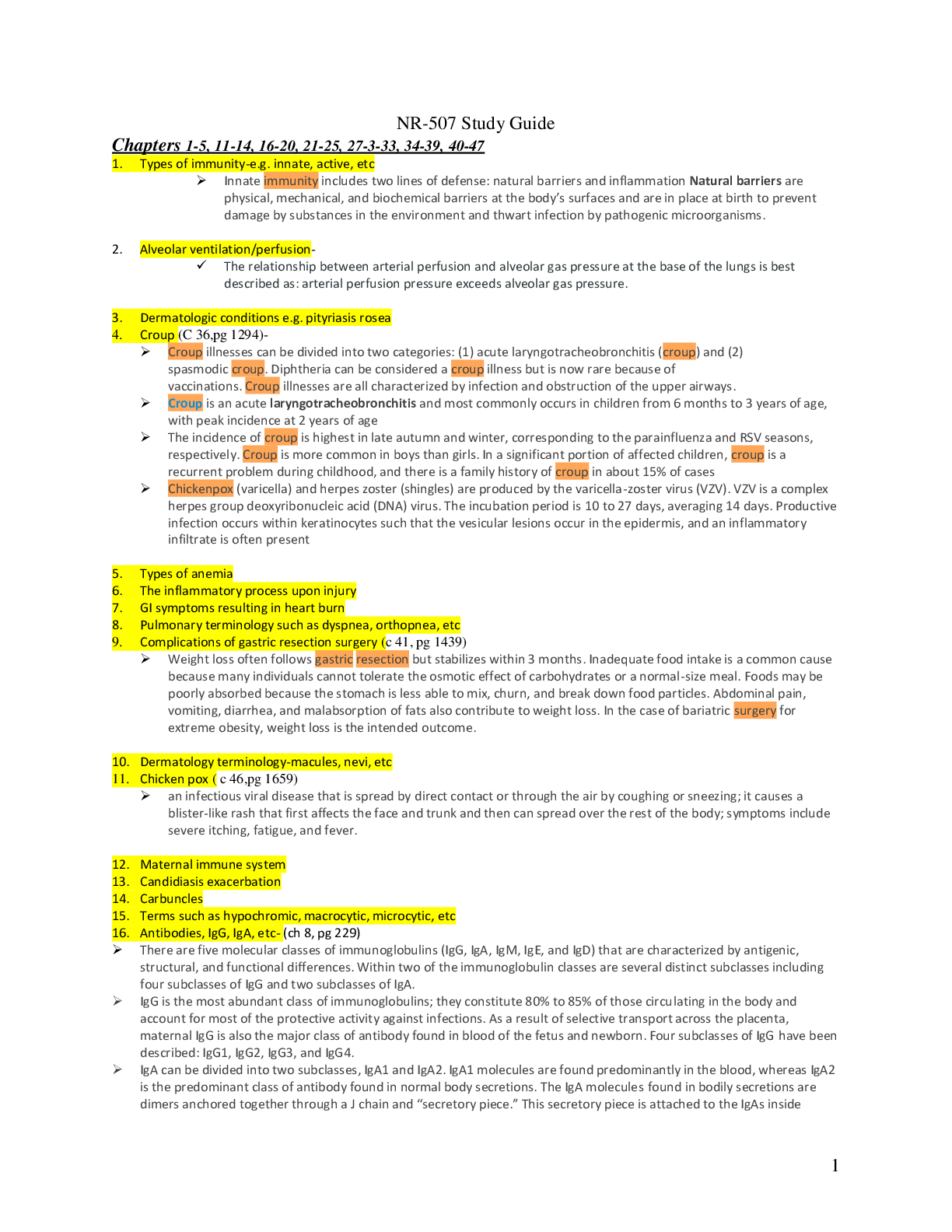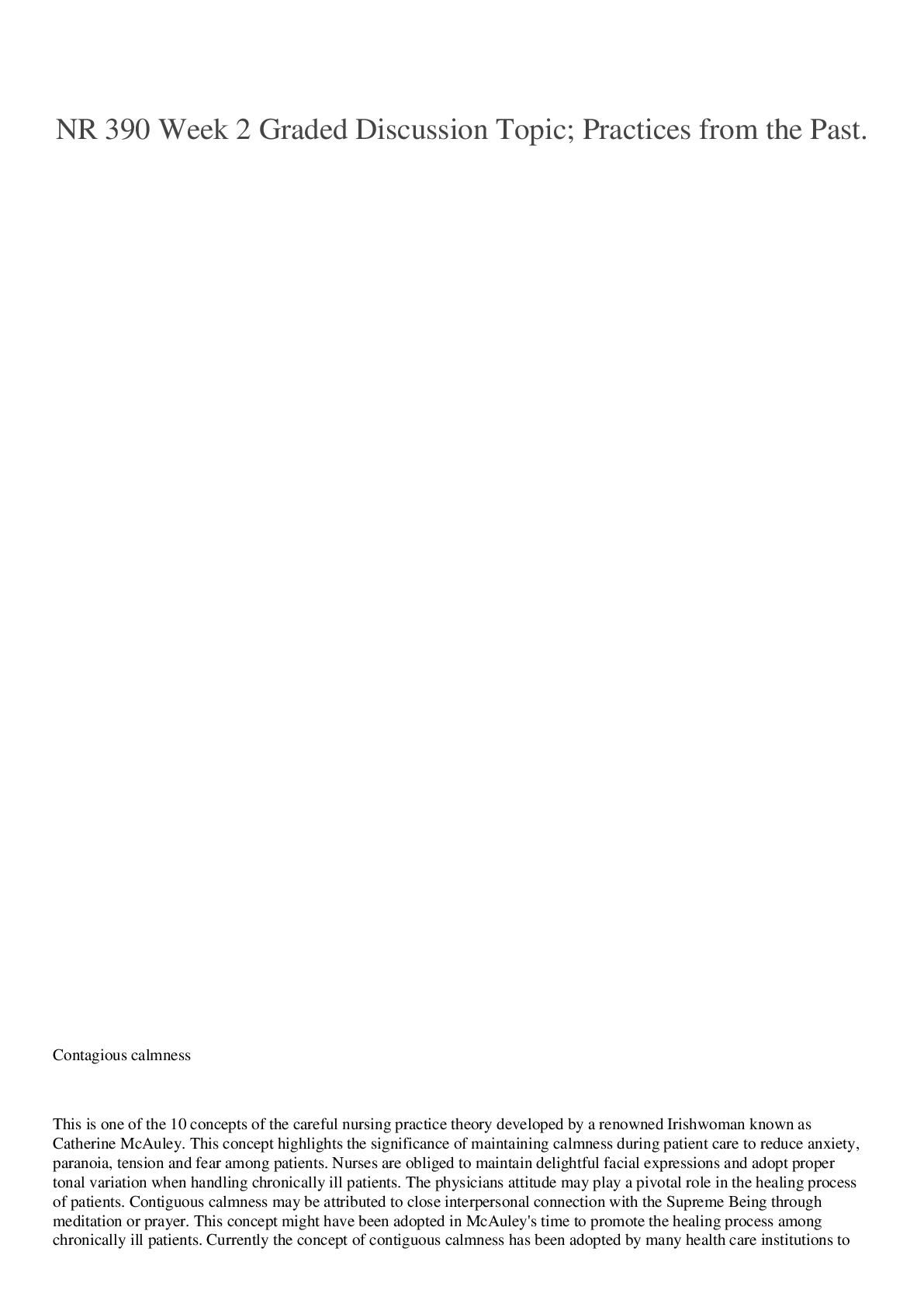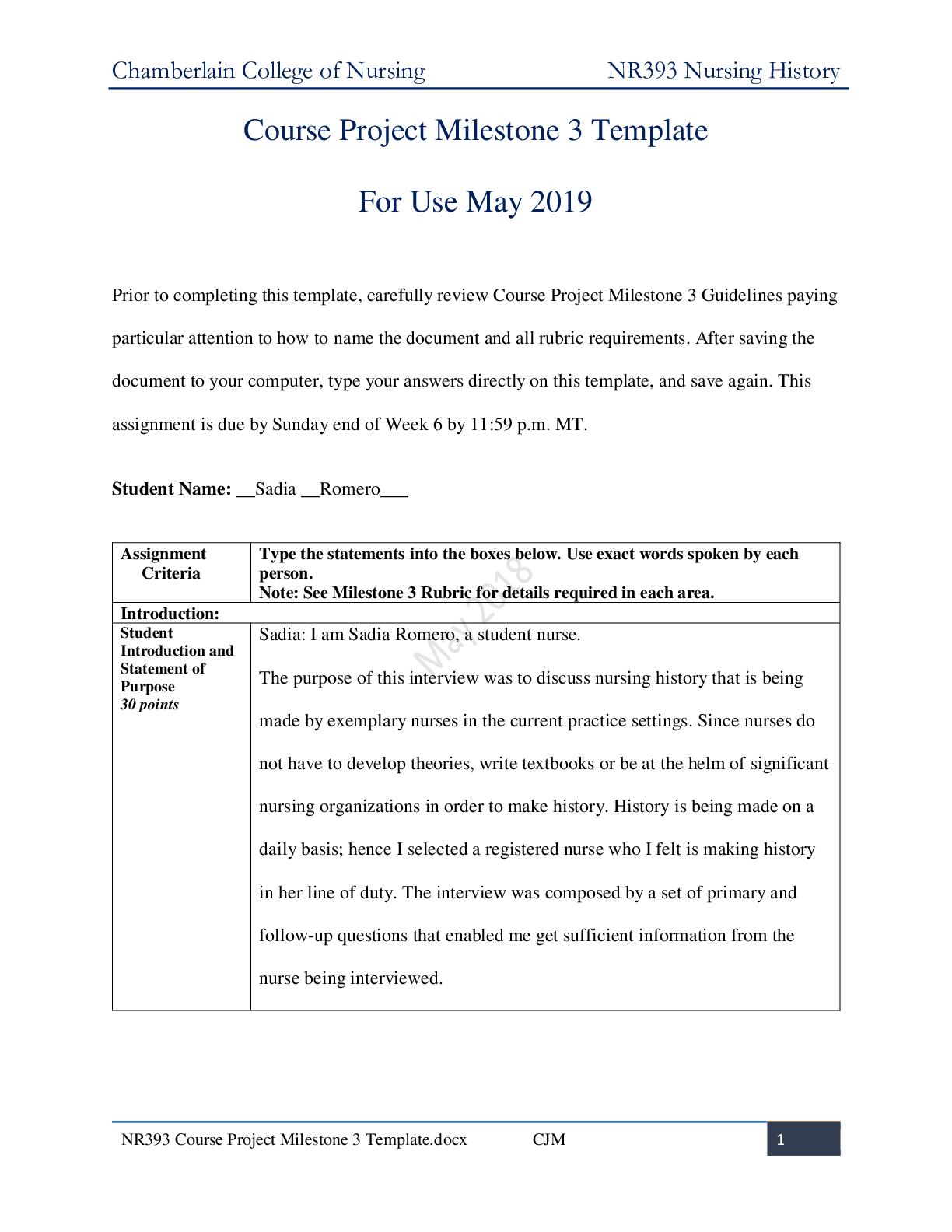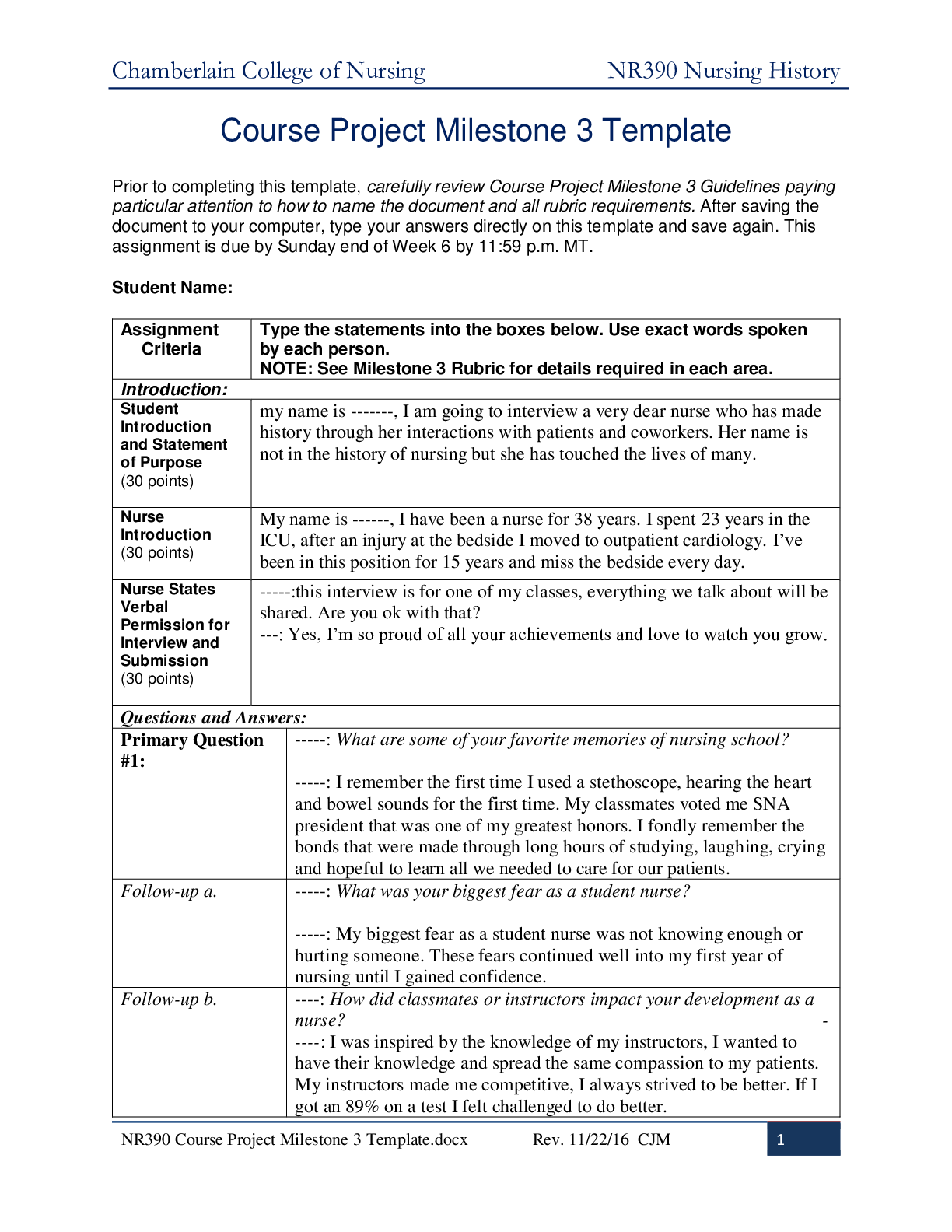*NURSING > STUDY GUIDE > NR 222 Unit 6 Health and Wellness Study guide {2020} - Chamberlain college of nursing {A+} | NR222 U (All)
NR 222 Unit 6 Health and Wellness Study guide {2020} - Chamberlain college of nursing {A+} | NR222 Unit 6 Health and Wellness Study guide {2020} - {A+}
Document Content and Description Below
NR 222 Unit 6 Health and Wellness Study guide {2020} - Chamberlain college of nursing {A+} Unit 6 Edelman: Ch 15 1. Overview of growth and development 2. Growth a. Quantifiable change in stru... cture b. In the body, this change means an increase in the number and/or size of the cells, resulting in an increase in the size and weight of the whole, or any of its parts c. During childhood, physical changes in height, weight, and head circumference, or growth parameters, are measured and charted regularly d. also refers to the increases (and as we age, decreases) in the size of specific organs and systems e. genetic factors, prenatal and postnatal exposures, nutrition, environmental factors, emotional health as well as traditional cultural practices that influence childrearing, lifestyle, and health care practices influence growth 3. Growth patterns a. Growth is not steady throughout life b. The periods of extremely rapid growth (prenatal, infancy, and adolescence) are contrasted with slower rates of growth (toddler, preschool,and school-age periods) c. Different parts of the body increase in size at different rates d. during early life the head is the fastest growing section (1/4 of length vs 1/9 in adults), followed by the trunk, and then the arms and legs 4. Growth charts a. Accurate growth assessment depends on precise measurement of growth parameters using proper equipment, correct and consistent techniques, careful plotting of measurements, and thoughtful interpretation of the data b. Use 2006 WHO growth charts for 0-24months c. Use 2000 CDC growth charts for 2-20 years d. growth charts describe weight-for-age, length (or stature)-for-age, weight-for-length, and BMI-for-age, and include the 5th and 95th and the 3rd and 97th percentiles e. a single measurement taken at one point in time, although helpful in providing a baseline, does not allow for the best assessment of a child’s growth f. instead, Serial measurements, plotted on a growth chart over time, best reflect a child’s pattern of growth g. Slowed growth, plateaus, or decreases in height, weight, and head circumference, as well as rapid increases, raise questions for health care providers about the adequacy of a child’s nutritional intake, syndromes or disease states, neglect, or emotional problems 5. Concept of development a. Development refers to gradual change and expansion of ability and advance in skill from a lower to a more-advanced complexity b. is a qualitative change, so is more challenging to describe because can’t use units 6. Developmental patterns a. one stage of development building on and leading to the next i. early developmental pattern: 1. Cephalocaudal- head to toe (Infants gain neck and head control before controlling the movements of the extremities) 2. Proximodistal- midline to periphery (Infants’ central nervous systems develop before peripheral nervous systems) 3. Differentiation- follows a pattern simple to complex, and general to specific (Infants use a whole-hand grasp before learning the finer control of the pincer grasp, and they coo or babble before they speak) b. Although the sequence of development is predictable, the exact timing of the sequencing is individual because individuals develop at their own rate, on their own schedule c. Denver Developmental Screening Test is a screening tool that assists health care providers in monitoring children’s development in each of these areas from birth to 6 years of age d. Social expectations can influence when developmental tasks are learned, but cultural expectations can determine which developmental tasks are learned e. Learning is the process of gaining specific knowledge or skills that result from exposure, experience, education, and evaluation f. Maturation is an increase in competence and adaptability that reflects changes in the complexity of a structure that makes it possible for that structure to begin to function or to function at a higher level g. Learning cannot occur unless the individual is mature enough to understand and control behavior (toilet training can’t be learned until sphincters have matured) 7. Theories of Development a. Psychosocial Development Theory (Erik Erikson) i. development of identity of the self through successive stages that unfold throughout the life span ii. based on the need of each person to develop a sense of trust in self and others and a sense of personal worth AGE GROUP PSYCHOSOCIAL STAGE LASTING OUTCOMES 1. Infancy Basic trust versus basic mistrust Faith and hope 2. Toddler stage Autonomy versus shame and doubt Self-control and willpower 3. Preschool stage Initiative versus guilt Direction and purpose 4. School age Industry versus inferiority Method and competence 5. Adolescence Identity versus role confusion Devotion and fidelity 6. Young adulthood Intimacy versus isolation Affiliation and love 7. Middle adulthood Generativity versus stagnation Production and care 8. Older adulthood Ego integrity versus despair Renunciation and wisdom iii. based on critical stages, each requiring resolution of a conflict between two opposing forces iv. Each stage depends on the preceding stage, which must be accomplished successfully for the person to proceed v. acknowledges the influence of other people and the environment but maintains that it is ultimately the individual who must master each of the conflicts b. Cognitive Development Theory (Jean Piaget) i. viewed children as biological organisms interacting with their environment, and his theory contends that cognitive development reflects children’s attempts to make sense of their worlds ii. major criticism of his work is that he underestimated children’s capabilities and gave little or no consideration for cultural differences iii. concerned primarily with structure rather than content, with how the mind works rather than with what it does iv. Each person is striving to maintain a balance, or equilibrium, between assimilation and accommodation v. Through a natural unfolding of ability, the child acquires sequentially predictable cognitive abilities; given adequate environmental stimuli and an intact neurological system, the child gradually matures toward full ability to conceptualize vi. believed that development preceded learning STAGE AGE CHARACTERISTICS Sensorimotor Birth to 2 years Begins with a predominance and reliance on reflexes that permit the body to learn Reflexes decrease and voluntary acts develop Imitation predominates Thought is dominated by physical manipulation of objects and events Develops the concept of object permanence and the ability to form mental representations Preoperational 2 to 7 years Advancing use of language and movement Development of egocentric, animistic, and magical thinking Uses representational thought to interpret and learn, not in terms of general properties, but in terms of the relationship or use to them No cause-and-effect reasoning Thought is dominated by the senses—what is seen, heard, or experienced Concrete operations 7 to 11 years Mental reasoning processes assume logical approaches to solving concrete problems, including cause and effect Collecting; mastering facts Can consider other points of view Thought influenced by social contacts Language is perfected Formal operations 11 to 15 years True logical thought and manipulation of abstract concepts emerge Morality established c. Cognitive Development Theory (Vygotsky) i. proposed that learning precedes development ii. while learning may be similar among children at certain times or phases of development, it is not identical in all children because of their differing social and cultural experiences iii. There are no predetermined levels of development; rather, experience is in the front, leading and expanding development in unlimited ways zone of proximal development is the distance between the actual - - - - - - - - - - - - - - - - - - - - -- -- - - - - - - - - - - -1. Sleep-Rest Pattern a. Inability to sleep is a frequent concern b. sleep apnea, the inability to fall asleep, the inability to stay asleep, the inability to fall back to sleep when awakening in the night, or the feeling of not being refreshed when awakening in the morning c. more likely to report excessive sleepiness as “somnolence, hypersomnia, excessive daytime sleepiness, and subjective sleepiness” d. Quality sleep results in overall increases in energy, motivation to continue a high quality of life, and improved immune function e. Pittsburgh Sleep Quality Index (PSQI) is a subjective tool that is helpful in assessing the quality and patterns of sleep and measures 7 areas: i. subjective sleep quality, sleep latency, sleep duration, habitual sleep efficiency, sleep disturbances, use of sleeping medication, and daytime dysfunction f. Identifying normal bedtime rituals, such as drinking a glass of milk, taking a relaxing bath, reading, or meditating, and ensuring that the person is able to continue these practices may help to establish normal sleep routines g. daytime napping has been viewed as inhibiting a good night’s sleep h. avoidance of long-term use of sleep medications (benzodiazepines, barbiturates, and chloral hydrate) for treatment of insomnia in older adults because of older adults’ increased sensitivity to these drugs, increased risk of dependency, and the decreased metabolism of long-term agents resulting in an increased risk for cognitive impairment, falls, and overdose 2. Cognitive-Perceptual Pattern a. Cognition i. Brain weight decreases with aging, and a shift occurs in the proportion of gray matter to white matter ii. cognitive problems are not a normal change of aging and many live well into old age without ever experiencing dementia iii. confusion is not always indicative of dementia, but can be the result of many treatable health problems including electrolyte imbalances, diabetic ketoacidosis, and hypoxia iv. Mild cognitive impairment (MCI) is a pathological collection of symptoms that results in memory loss, language difficulties, and impairments in judgment and reasoning v. instrumental activities of daily living will help the nurse identify changes in higher executive functions, such as paying bills, taking medications as ordered, using the phone, and driving safely vi. Dementia is a “group of cognitive disorders characterized by memory impairment, marked difficulty in the domains of language, motor activity, object recognition, and disturbance of executive function” vii. multi-infarct dementia, which is caused by the death of brain tissue and diagnosed through brain imaging, can be caused by lack of blood flow viii. Alzheimer’s disease (AD), the most common type of dementia ix. Other dementia: Parkinson-related dementia, Huntington’s disease, Creutzfeldt-Jakob disease, Pick disease, and Lewy body dementia x. symptoms of dementia include forgetfulness, inattentiveness, disorganized thinking, altered levels of consciousness, perceptual disturbances, sleep-wake disorders, psychomotor disturbances, and disorientation xi. Mini-Mental State Examination (MMSE) is used to screen for cognitive impairments (23 or lower= problem with cognition) xii. Treatment for AD includes the use of medications for memory loss including cholinesterase inhibitors and memantine, treatments for behavioral changes xiii. developing and keeping routines; working in a calm, gentle, and unhurried manner; encouraging self-care activity; and reducing sensory overload xiv. Nurses encourage older individuals to take classes, read, engage in stimulating conversation and entertainment, keep their minds active, and continue learning throughout their lives b. Sensory factors i. A variety of structural changes cause visual acuity to decrease, color discrimination to become less acute, pupil size and constriction ability to decrease, and peripheral vision to diminish ii. Hearing deficits are common in old age, resulting from inner ear atrophy or sclerosis of the tympanic membrane iii. Presbycusis is a progressive sensorineural hearing loss associated with aging and results in difficulty filtering background noise and understanding higher pitched voices iv. Loss of hearing results in decreased quality of life and is associated with decreased function, miscommunication, loss of self-esteem, depression, falls, safety risks, and cognitive decline v. nurse routinely assesses for the accumulation of cerumen(earwax) to ensure optimal hearing vi. Taste changes with aging because of a loss of taste buds vii. sensations brought about by touch may also diminish with the decrease in sensory nerve endings, especially in the presence of debilitating diseases such as diabetes, stroke, or Parkinson’s disease viii. ability to smell and the acuity of the olfactory nerve also decrease, so need to check dates on food ix. Periodontitis (gum disease) leading to tooth loss among adults, is a common contributor to decreased taste sensation and poor nutrition x. inability to chew and swallow food in a comfortable manner works synergistically with decreased smell and taste sensations and other problems that inhibit proper nutrition xi. sweating decreases and injuries take longer to heal, the skin remains capable of sensing and carrying out its protective role xii. Cerebrovascular accidents (CVAs) (strokes) or neuropathies resulting from diabetes are two examples of diseases that disrupt the ability to feel pain and pressure through the skin xiii. A pressure sore (decubitus ulcer) is a localized area of tissue necrosis that develops when soft tissue is compressed between two bony prominences or between bony prominence and external surface for a prolonged period 3. Self-Perception Self-Concept Pattern a. culture, environment, family, lifestyle factors, and heredity combine to form self-concept b. Self-concept includes an individual’s attitudes, perception of abilities (cognitive, affective, or physical), body image, identity, general sense of worth, and general emotional pattern c. Erikson’s theory i. Ego integrity versus despair is the developmental stage ii. process of bringing into balance feelings of integrity and despair involves a review of and a coming to terms with the life one has lived thus far iii. Based on the increasing life span, this stage of development was expanded into three additional stages: 1. ego differentiation versus work role preoccupation (which involves achieving identity apart from work) 2. body transcendence versus body preoccupation (which focuses on adjusting to normal aging changes) 3. ego transcendence versus ego preoccupation (involves accepting death) iv. Two successful methods of assistance for older adults at all cognitive levels are reminiscence (multifaceted, multipurpose, naturally occurring mental phenomenon manifested across the life span in a variety of forms and contexts) and life review (formal therapy technique taking the person through their life in a structured and chronological order) 4. Roles-Relationships Pattern a. source of an individual’s self-perception often changes with older adulthood b. formation of the self that has focused on a person’s role in family changes when children become independent or spouse dies and changes to role of grandparent c. Coping strategies significantly correlated with less stress included accepting responsibility, confrontive coping, self-control, positive reappraisal, planned problem solving, and distancing d. Retirement influences: having poor health, wanting to do other things, not liking their work, and wanting to spend more time with family e. Factors for satisfaction with retirement: good health and functional ability, adequate income, a suitable living environment, a strong social support system, and a positive outlook f. Volunteering can be an effective method for older adults to continue to feel engaged in the community as a productive, contributing member of society g. Federal and state funding has created a number of subsidized work programs for older adults 5. Sexuality-Reproductive pattern a. defines sexual health as a state of physical, emotional, mental and social well-being in relation to sexuality; it is not merely the absence of disease, dysfunction or infirmity and requires a positive and respectful approach to sexuality and sexual relationships, as well as the possibility of having pleasurable and safe sexual experiences b. myths: older men have erectile dysfunction (impotence) and are unable to have sexual intercourse; after menopause, older women no longer have sexual desire; there are physical and psychological reasons that older adults are unable to have sexual intercourse; an aging body is not sexy; and older people shouldn’t have sex c. predictor of sexual interest in older adulthood is the enjoyment and frequency of sex at a younger age d. chronic medical conditions, such as cardiac problems, arthritis, and normal aging changes that can make sexual intercourse difficult e. lack of circulating hormones in both men and women results in changes in four areas of the sexual system: arousal, orgasm, postorgasm, and extragenital changes f. vagina becomes narrower, shorter, and thinner,and there is less natural lubrication g. less intense and slower erections, increased difficulty regaining an erection, decreased force of ejaculation, and an extended refractory time 6. Coping-Stress Tolerance Pattern a. As people age, they tend to encounter many losses, such as the loss of a home, spouses, friends, and siblings; also experience declines in income, and in health and physical functioning b. Depression i. mainly affects those with chronic illnesses and cognitive impairment, and results in suffering, family disruption, and disability ii. arteriosclerosis and endocrine and immune system changes, compromise the integrity of frontostriatal pathways, the amygdala, and the hippocampus, and increase vulnerability to depression iii. Psychosocial adversity (economic impoverishment, disability, isolation, relocation, caregiving, and bereavement)contributes to physiological changes, further increasing susceptibility to depression iv. Some common behaviors include sullen affect, lack of appetite and weight loss, sleep disorders, fatigue, decreased ability to think or concentrate, psychomotor agitation, decreased participation in daily living and social activities, social withdrawal, and suicidal ideation c. Suicide i. Risk factors for suicide include social isolation, alcohol and substance abuse, psychosis, bereavement, and serious medical illness 7. Values-Beliefs Pattern a. spiritual process of meaning-making (or seeking significance in an event) can touch on all aspects of life, including work, interpersonal relationships, general philosophy of living, attitudes, and/or whatever that person’s “God” may be b. Open-ended questions, such as, “What is your perception of a higher being and spirituality?” can encourage discussions about the person’s innermost spirituality c. nurse can provide an environment that is supportive to the practice of the person’s [Show More]
Last updated: 1 year ago
Preview 1 out of 58 pages
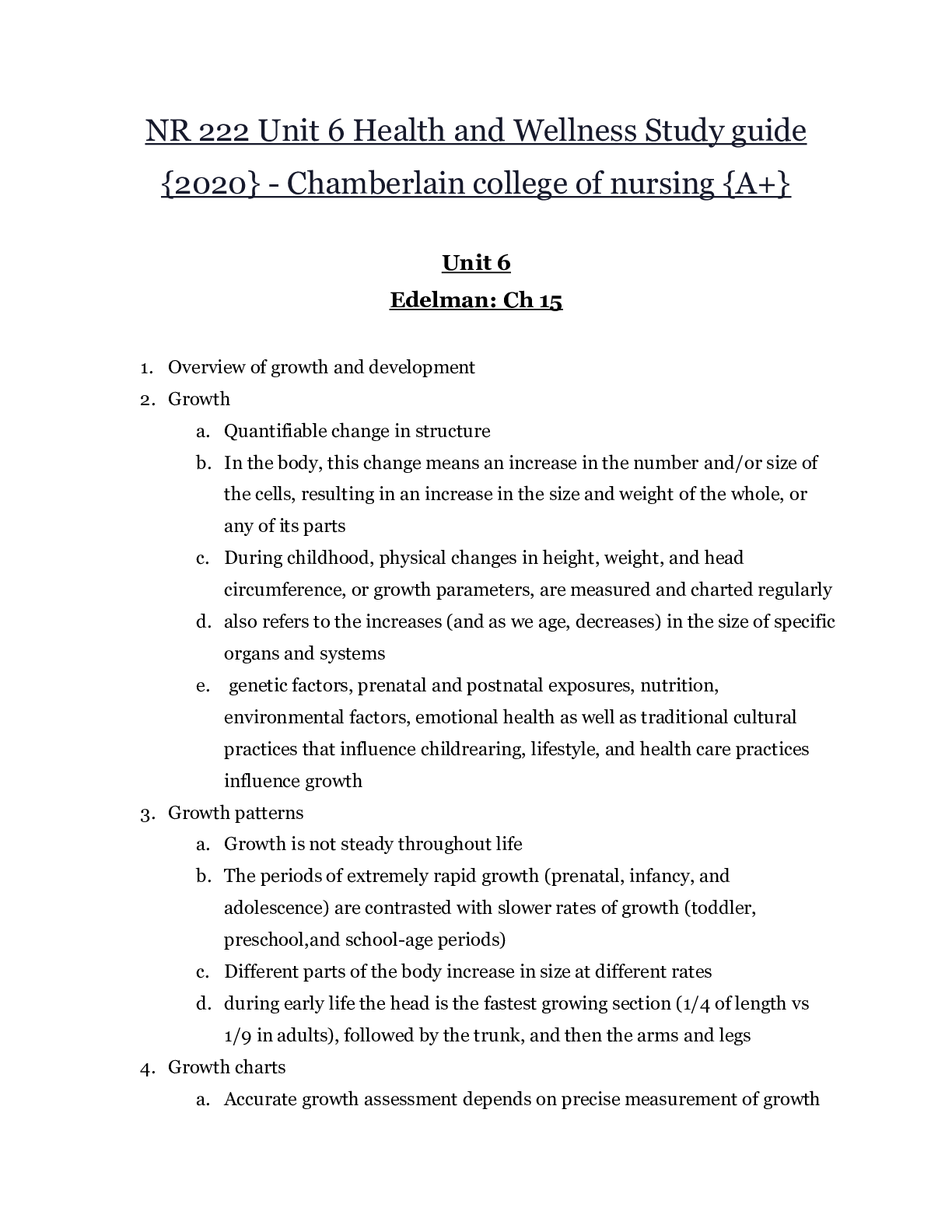
Buy this document to get the full access instantly
Instant Download Access after purchase
Add to cartInstant download
We Accept:

Reviews( 0 )
$11.50
Document information
Connected school, study & course
About the document
Uploaded On
Jan 21, 2021
Number of pages
58
Written in
Additional information
This document has been written for:
Uploaded
Jan 21, 2021
Downloads
0
Views
37

